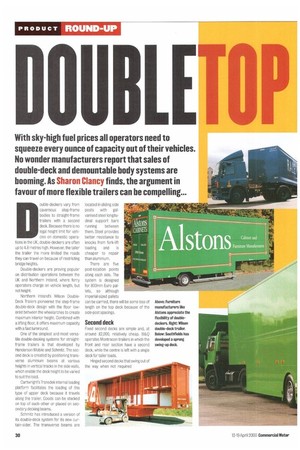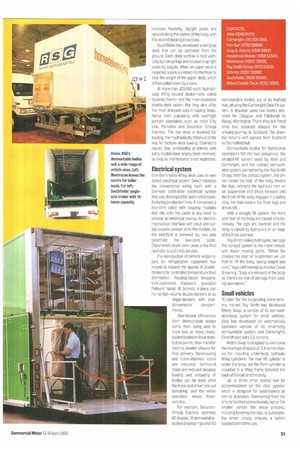ouble-deckers vary from cavernous step-frame bodes to straight-frame trailers with
Page 32

Page 33

If you've noticed an error in this article please click here to report it so we can fix it.
a second deck. Because there is no legal height limit for veNcles on domestic operations in the UK, double-deckers are often up to 4.8 metres high. However, the taller the trailer the more limited the roads they can travel on because of restricting bridge heights.
Double-deckers are proving popular on distribution operations between the UK and Northern Ireland, where ferry operators charge on vehicle length, but not height.
Northern Ireland's Wilson DoubleDeck Trailers pioneered the step-frame double-deck design with the floor lowered between the wheelarches to create maximum interior height. Combined with a lifting floor, it offers maximum capacity with a fast turnround.
One of the simplest and most versatile double-decking systems for straightframe trailers is that developed by Henderson Mobile and Schmitz. The second deck is created by positioning transverse aluminium beams at various heights in vertical tracks in the side walls, which enable the deck height to be varied to suit the load.
Cartwright's Transdek internal loading platform facilitates the loading of this type of upper deck because it travels along the trailer. Goods can be stacked on top of each other or placed or secondary decking beams.
Schmitz has introduced a version of its double-deck system for its new curtain-sider. The transverse beams are located in sliding side posts with galvanised steel longitudinal support bars running between them. Steel provides better resistance to knocks from fork-lift loading and is cheaper to repair than aluminium.
There are five post-location points along each side. The system is designed for 800mm Euro pallets, so although imperial-sized pallets can be carried, there will be some loss of length on the top deck because of the side-post spacing&
Second deck
Fixed second decks are simple and, at around £2,000, relatively cheap. B&Q operates Montracon trailers in which the front and rear section have a second deck, while the centre is left with a single deck for taller loads.
Hinged second decks that swing out of the way when not required Increase flexibility. Upright posts are spaced along the centre of the body, with the second decking in sections.
Southfields has developed a swing-up deck that can be operated from the ground. Each deck section is held vertically by coil springs and located in upright posts by spigots. When an upper deck is required, a pole is slotted into the floor to take the weight of the upper deck, which is then pulled down by a cord.
At more than £20,000 each, hydraulically lifting second decks—also called dynamic floors—are the most expensive double-deck option. But they also offer the most dramatic cuts in loading times, hence their popularity with overnight parcels specialists such as Initial City Link, Parceling and Securicor Omega Express. The top deck is lowered for loading, then hydraulically lifted out of the way for bottom deck loading. Operators report that unreliability problems with early models have largely been resolved, as long as maintenance is not neglected.
Electrical system
Don-Bur's latest lifting deck uses its new Select electrical system. Select replaces the conventional wiring loom with a Siemens solid-state electrical system that was developed for automated manufacturing production iines. It comprises a two-core cable with coupling modules that clip onto the cable at any point to provide an electrical source. An electromechanical interface with input and output sockets screws on to the module. As the interface is screwed on, two pins penetrate the two-core cable. Department store John Lewis is the first operator to put it into service.
The introduction of remote evaporators on refrigeration equipment has helped to expand the appeal of doubledeckers for controlled-temperature food distribution. Reading-based temperature-controlled transport specialist Pulleyns' latest 10 Schmitz trailers can run as high-volume double-deckers eras single-deckers with dual
temperature compartments.
Operational efficiencies from demountable bodies come from being able to trunk two or more readyloaded bodies to local distribution points, then transfer them to smaller chassis for final delivery. Warehousing and trans-shipment costs are reduced; turnround times are reduced because loading and unloading of bodies can be done while the truck and driver are out delivering; and the whole operation needs fewer vehicles.
For example, Securicor Omega Express operates 60 chassis, 18 demountablebodied drawbar rigs and 172 demountable bodies out of its Hatfield hub, all using the Cartwright Clearlift system. A drawbar takes two bodies destined for Glasgow and Edinburgh to Risley, Warrington. There they are fitted onto two separate chassis for the onward journey to Scotland. The drawbar returns with parcels from Scotland to the Hatfield hub.
Demountable bodies for distribution operations fall into two categories: the straight-lift system used by Abel and Cartwright, and the contact demountable system, pioneered by the Ray Smith Group. With the contact system, the driver raises the rear of the body, lowers the legs, retracts the hydraulic ram or air suspension and drives forward until the front of the body engages in a safety stop. He then lowers the front legs and drives off.
With a straight lift system, the front and rear of the body are raised simultaneously The legs are lowered and the body is raised by hydraulics or air bags at the front and rear.
Ray Smith makes both types, but says the contact system is the more robust, with fewer moving parts. 'When the chassis has rear air suspension we use .that to lift the body, saving weight and cost," says joint managing director David Browning. "Legs are inboard of the body so there's no risk of damage from loading operations."
Small vehicles
To cater for the burgeoning home-delivery market Ray Smith has developed Metro Swap, a version of its demountable-body system for small vehicles. Abel has developed an automatically operated version of its small-body demountable system; and Cartwright's Clearlift also suits 3.5-tonners.
Metro-Swap is designed to overcome the shortage of space on 3.5-tonne chassis for mounting under-body hydraulic lifting cylinders. The rear lift cylinder is under the body, but the front cylinder is mounted in a lifting frame between the back of the cab and the body.
Up to three small bodies can be accommodated on the Abel system, which is designed for semi-trailers as well as drawbars. Demounting from the chic is handled conventionally, but on the smaller vehicle the whole process, including lowering the legs, is automatic: the driver simply presses a button located behind the cab.












































































































